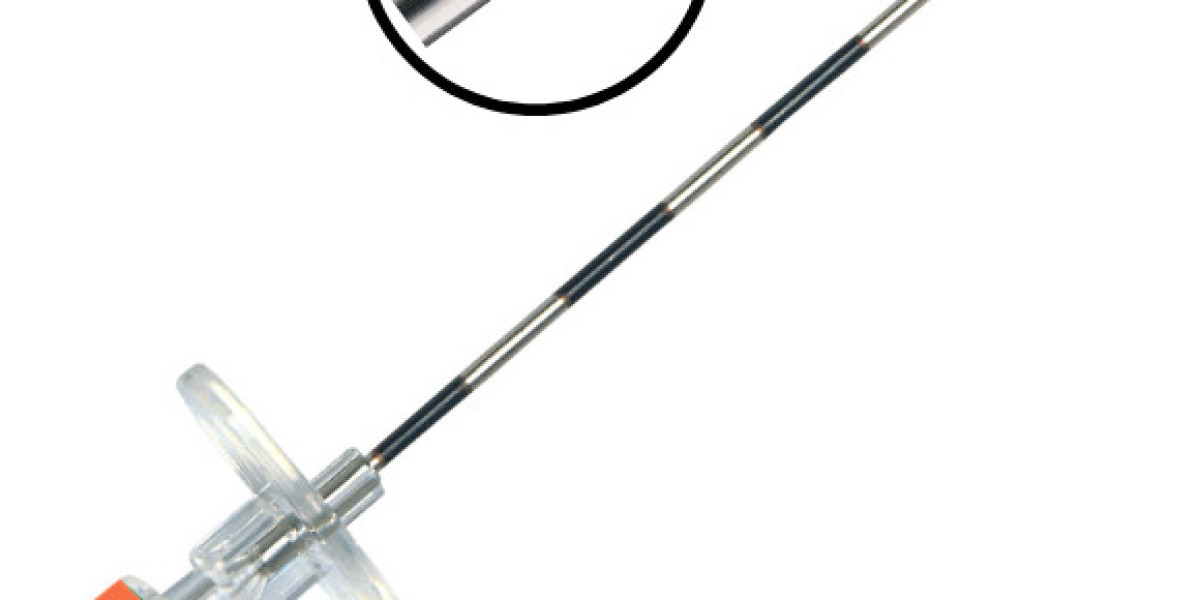Key Features of Spinal Needles:
Gauge and Length: Spinal needles are available in various gauges and lengths, catering to diverse patient anatomies and procedural requirements. The gauge of a needle refers to its thickness, with lower gauge numbers indicating thicker needles. Common spinal needle gauges range from 20 to 27, with 20-gauge needles being thicker and 27-gauge needles being thinner. The length of spinal needles typically varies from 3 to 5 inches, with longer needles often used for patients with larger body sizes or for procedures requiring deeper penetration into the spinal canal.
Tip Styles: Spinal needles feature different tip styles designed to suit specific procedural needs. Common tip styles include the Quincke and Whitacre tips. The Quincke tip, characterized by its beveled edge, is ideal for quick and efficient fluid collection during lumbar punctures. In contrast, the Whitacre tip, with its pencil-point design, aims to minimize post-procedural headaches and discomfort, making it suitable for sensitive patients or procedures requiring precise medication delivery.
Materials and Sterility: High-grade stainless steel or medical-grade alloys are commonly used in the manufacturing of spinal needle. These materials ensure the durability, strength, and compatibility of the needles with sterilization processes, thereby maintaining aseptic conditions until the needles are used in medical interventions. Spinal needles are packaged to retain their sterility, with rigorous quality control measures implemented to ensure compliance with safety standards and patient well-being.
Applications of Spinal Needles:
Lumbar Punctures: Lumbar punctures are diagnostic procedures that involve the insertion of a spinal needle into the subarachnoid space of the lumbar spine to collect cerebrospinal fluid (CSF). CSF analysis obtained through lumbar punctures aids in the diagnosis of various neurological conditions, including infections, bleeding, tumors, and inflammatory diseases of the central nervous system.
Spinal Anesthesia: Spinal anesthesia, also known as spinal block or subarachnoid block, is a regional anesthesia technique that involves the administration of local anesthetic spinal needle sizes medications into the subarachnoid space via a spinal needle. This technique induces temporary numbness and loss of sensation in the lower half of the body, making it suitable for surgical procedures below the umbilicus, childbirth, and postoperative pain management.
Innovations and Advancements in Spinal Needle Technology:
Recent advancements in medical technology have led to the development of innovative spinal needle designs and materials, aimed at enhancing procedural efficiency, patient comfort, and safety. Some notable innovations include:
Ultra-Thin Needles: Manufacturers have introduced ultra-thin spinal needle with finer gauges, allowing for less traumatic insertion and reduced risk of tissue damage. These needles are particularly beneficial for sensitive patients or procedures requiring precise medication delivery.
Ergonomic Designs: Modern spinal needles feature ergonomic designs with enhanced grip surfaces and hub configurations, facilitating secure handling and precise needle control during procedures. Ergonomic enhancements minimize the risk of slippage or accidental needle displacement, ensuring procedural accuracy and patient safety.
Coating Technologies: Advanced coating technologies, such as silicone lubrication or hydrophilic coatings, are applied to spinal needles to reduce friction and resistance during insertion. Coated needles glide smoothly through tissues, minimizing patient discomfort and procedural trauma while maintaining procedural efficiency.
Needle Visualization Techniques: Innovative needle visualization techniques, such as ultrasound guidance or fluoroscopy, are employed to improve the accuracy and precision of spinal needle placement. Real-time imaging allows healthcare providers to visualize the needle trajectory and monitor its advancement, ensuring optimal positioning within the spinal canal.
These needles are crucial in medical interventions such as lumbar punctures for diagnostic purposes and administering spinal anesthesia for surgical procedures or pain management. They are characterized by their precise tips, which can be either beveled (Quincke tip) or pencil-point (e.g., Whitacre tip), designed to facilitate fluid collection or medication delivery while minimizing patient discomfort and post-procedural complications.
Quality Assurance and Safety Measures:
Ensuring the quality, safety, and reliability of spinal needles is paramount to their clinical utility and patient outcomes. get the details of other medical products on www.gstc.com. Manufacturers adhere to stringent quality assurance protocols and regulatory standards to guarantee the integrity and performance of spinal needles. Key safety measures include.
Rigorous Quality Control: Manufacturers implement rigorous quality control measures throughout the manufacturing process to maintain precise dimensions, sharpness, and structural integrity of spinal needles. Quality control protocols encompass material selection, fabrication techniques, and final product inspection to ensure compliance with safety standards and regulatory requirements.
Sterilization Protocols: Spinal needles undergo comprehensive sterilization processes to eliminate microbial contaminants and ensure their suitability for clinical use. Sterilization methods include autoclaving, ethylene oxide (EtO) sterilization, or gamma irradiation, depending on the needle's material composition and packaging requirements. Aseptic packaging further preserves the sterility of spinal needles until they are opened for use in medical procedures.
Regulatory Compliance: Manufacturers adhere to regulatory guidelines and standards established by international regulatory bodies, such as the U.S. Food and Drug Administration (FDA) or the European Medicines Agency (EMA). Compliance with regulatory needle used for lumbar puncture requirements ensures the safety, efficacy, and quality of spinal needle, providing healthcare providers and patients with confidence in their clinical utility.
A spinal needle, also known as a lumbar puncture needle or LP needle, is a medical instrument specifically designed for procedures involving the spinal canal. These needles are used to access the subarachnoid space in the lumbar region of the spine, allowing for the collection of cerebrospinal fluid (CSF) for diagnostic purposes or the administration of medications, such as anesthesia, into the spinal canal.
Recherche
Messages populaires
-
 Tea Tree Essential Oil - Antifungal and Antibacterial Properties for Healthy Hair and Skin
Par easywholesale
Tea Tree Essential Oil - Antifungal and Antibacterial Properties for Healthy Hair and Skin
Par easywholesale -
 WHICH GAME IS BETTER FOR YOUR BRAIN SPEED: SUDOKU OR SATTA?
Par sattaking0022
WHICH GAME IS BETTER FOR YOUR BRAIN SPEED: SUDOKU OR SATTA?
Par sattaking0022 -
 Custom CRM development - Tekki Web Solutions
Custom CRM development - Tekki Web Solutions
-
 Crepe Paper Market Size 2024: Emerging Opportunities and Projections through 2032
Par Prajaktap
Crepe Paper Market Size 2024: Emerging Opportunities and Projections through 2032
Par Prajaktap -
 Online Picture Framing Market Share 2024: Current Trends and Forecasts to 2032
Par Prajaktap
Online Picture Framing Market Share 2024: Current Trends and Forecasts to 2032
Par Prajaktap




